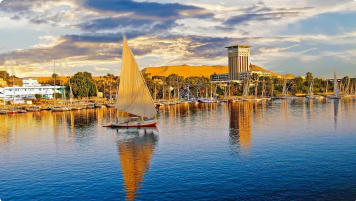Alexandria, Egypt
Article for senior couples and mature solo travellers curious about Egypt, Greek and Roman history. Including the links to Venice and the trade in Spice and grain. Join a small group educational tour to learn and discover more.
17 Dec 21 · 11 mins read
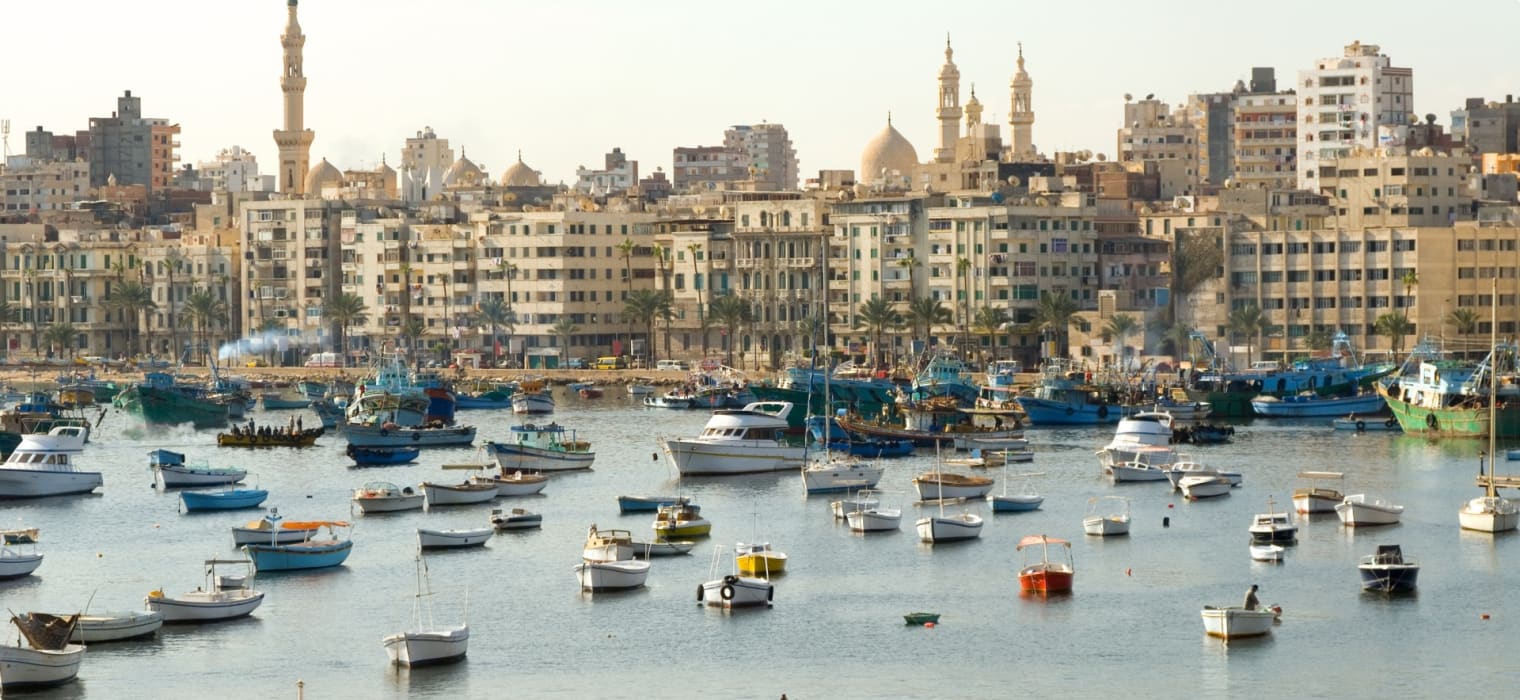
Hellenistic Alexandria
The city of Alexandria lies in the northwest part of Egypt along the Mediterranean Sea. Founded in 331 BCE by Alexander the Great, it would go on to thrive as the greatest city of the Mediterranean world during the Hellenistic age (between the death of Alexander in 323 BCE and the emergence of the Roman Empire in 31 BCE).
Due to its location, it served as a centre of commerce, an important trading post between Europe and Asia, linking the Mediterranean to the Red Sea and the Indian Ocean. The wealth in turn attracted a great deal of people to the city, bringing with them a mixture of different religions and philosophies. As such, it quickly became a centre of culture and scholarship, home to various artists, musicians, poets, mathematicians, philosophers, scientists, historians, and other intellectuals.
The city’s grandeur was reflected in a number of its massive structures, including the legendary ancient Library of Alexandria, as well as the Lighthouse of Alexandria (or Pharos of Alexandria) – one of the seven wonders of the ancient world.
Read on for a more detailed history of Alexandria in the Hellenistic period, intended as background reading for Odyssey Traveller’s Alexandria day tour as part of our Escorted Small Group History & Cultural Tour of Egypt for mature and senior travellers with a tour guide. Much of the information for this article is sourced from David Abulafia’s book The Great Sea, as well as other sources linked to throughout.

The Founding of Alexandria
Alexander the Great founded Alexandria in 331 BCE during his military campaign against the Persian Empire. Rather than pursuing the Persian King, Darius III, into the Persian heartlands, Alexander well understood he needed to neutralize Persian power along the shores of the Mediterranean. After taking over Phoenician cities in Syria and Palestine that had in the past provided Persia with its fleets, he turned his targets to Egypt. Egypt had at that point been ruled by a Persian satrap for nearly 200 years.
Alexander swept down into Egypt and captured the Satrapy in April 331 BCE. He then decided to found a city on the northernmost edge of Egypt, on a limestone spur separated form the alluvial lands of the interior by a freshwater lake. Bearing his name, Alexandria would be the capital of his new Egyptian dominion, replacing Neucratis as the Hellenistic centre in ancient Egypt. It would serve as a naval base to control the Mediterranean and link Greece with the rich Nile valley.
Alexander chose the ancient settlement of Rhakotis as the site for the city. Here he could make use of the abundance of water from Lake Maryūṭ and the good anchorage provided offshore by the island of Pharos. With this, he envisioned the building of a causeway from Alexandria to Pharos that would generate two great natural harbours.
Upon its founding, Alexandria was exceptionally large. It measured three miles (five kilometres) from west to east, and about a half from north to south. As in other new cities of the Mediterranean world, the streets were laid out in a grid pattern that still survive to a significant extent. The broad avenues of early Alexandria, however, have narrowed greatly, and little survives of the ancient city above the water line.

Only a few months after the city’s foundation, Alexander left Egypt to continue his conquest of Persia. He would die in Babylon eight years later at the age of only thirty-two, having never returned to Alexandria.
Upon his death, his empire was divided up among three competing generals, in Macedonia and Greece, Syria and the East, and Egypt. General Ptolemy Ladiges took over control of Egypt, bringing Alexander’s body with him, helping to cement his legitimacy. He buried the body in Memphis, before it was later transferred to Alexandria.
In 305 BCE, Ptolemy declared himself Pharoah of Egypt as Ptolemy I Soter (“the Saviour”) and moved his capital to Alexandria. Ptolemy’s family (the Ptolemaic Dynasty) then ruled Egypt until the Roman conquest of 30 BCE. Under the Dynasty, Alexandria grew into the greatest city of its time, serving as a centre of reinvigorated Greek culture that spread across the Mediterranean.
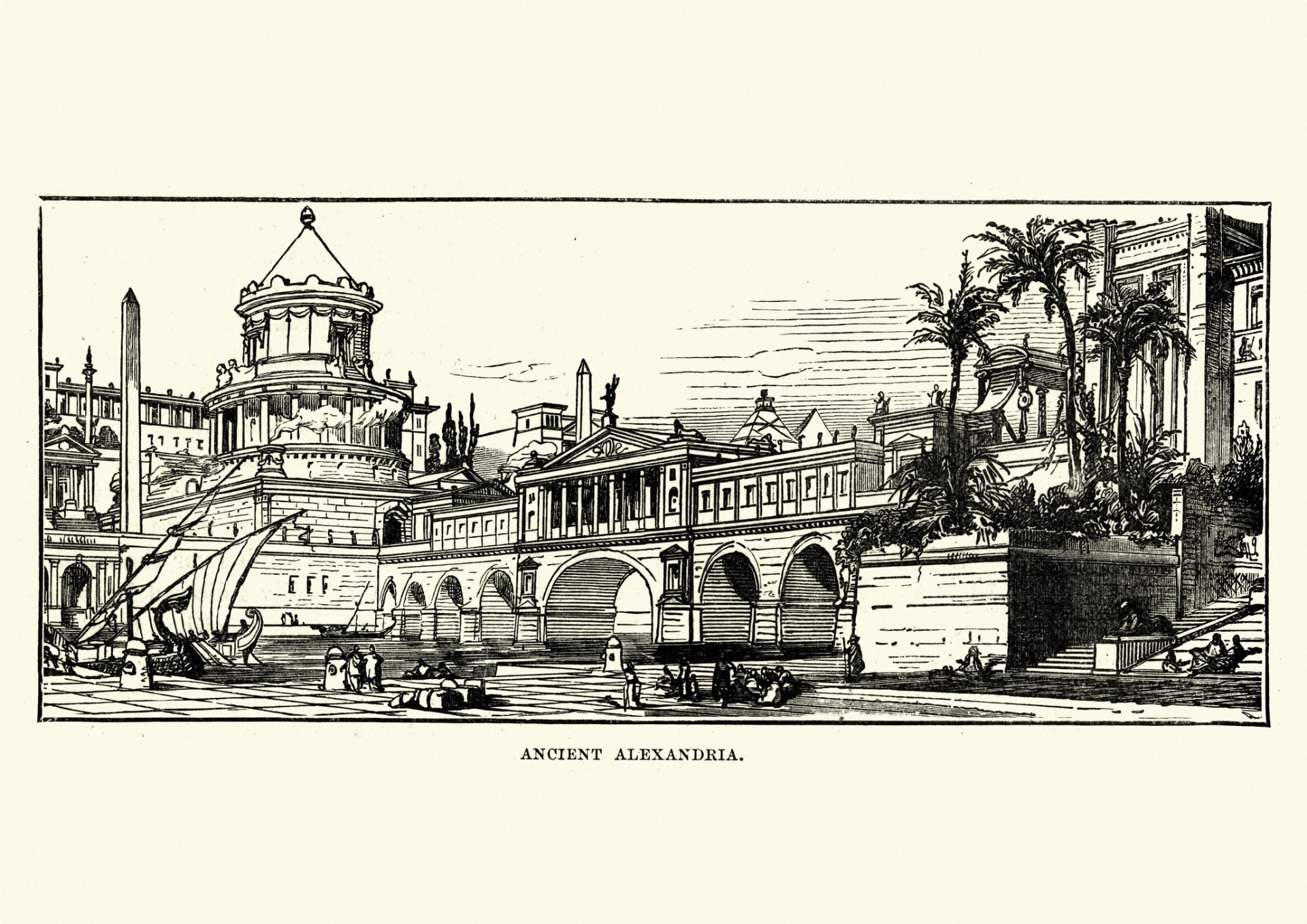
A Centre of Trade
Before the establishment of Alexandria, the Phoenician city of Tyre was the preeminent city for trade and commerce in the region. However, the city was destroyed by Alexander during his Persian campaign, and Alexandria was able to take its place.
Alexandria looked two ways, linking Egypt to the Mediterranean and Europe in one instance, and to Arabia and India through the Red Sea and Indian Ocean in the other. As such, the city quickly grew to prominence, gaining control of massive resources and attracting lucrative trade from all over. In less than a generation it was larger than Carthage, and within a century of its founding it had become the largest city in the world.
With a flourishing metal industry in Egypt, exports of gold, silver, and bonze plate became one of the strengths of Alexandria. These were accompanied by the export of textiles, pottery, and glass – a particular speciality. Papyrus was another Egyptian speciality in high demand in both neighbouring lands and more widely across the Mediterranean.
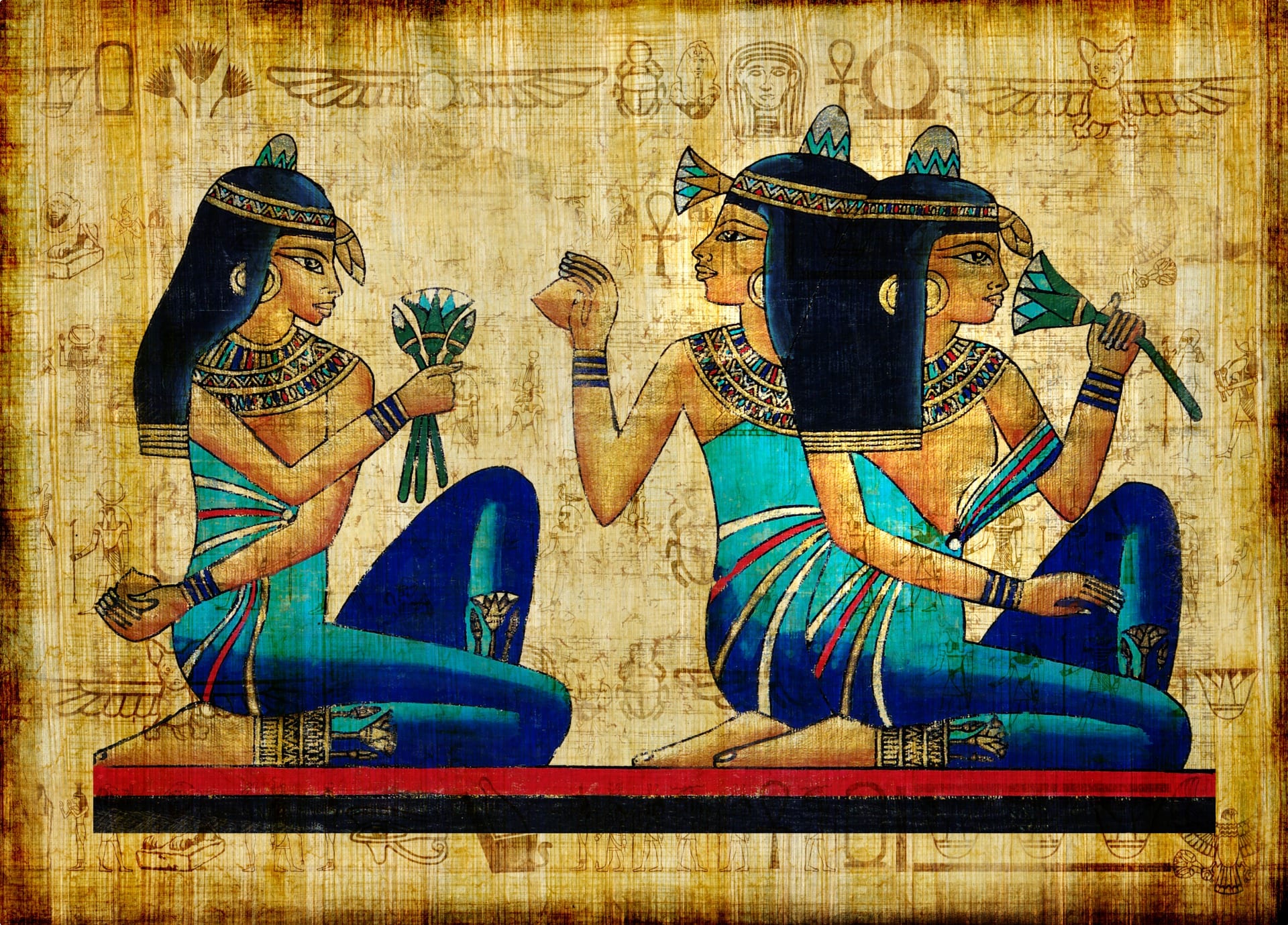
Meanwhile, various other European goods were traded through the city’s ports, including nuts from the Black Sea, cheese from Chios, olive oil, figs, honey, sponges, wool, wild boar meat, venison, goat’s meat, and of course wine, amongst other items.
The Ptolemies enforced a tight system of control of trade. Ships’ cargoes were closely examined at designated ports, and taxes were levied not just at the ports but at internal custom stations along the Nile as goods moved up to Alexandria. Taxes represented a percentage of the estimated value of the cargo, reaching as much as 50 per cent on some items (such as wine and oil) and sometimes only a third or a quarter.
Large profits also came to the Alexandrians serving as middlemen in the trade linking the Indian Ocean to the Mediterranean. Gold, frankincense, and myrrh were prized items carried up the Red Sea. Meanwhile Indian goods and spices also became familiar in Alexandria, and the Ptolemies profited from access to African and Indian elephants for their army.
The product that came to dominate the business of Alexandria was, however, grain. It was produced both to feed the city and for export markets. Rhodes was a particularly keen customer of Egyptian wheat for itself and for many of its trading partners. Further export markets then later opened up following a series of Celtic and Scythian tribe invasions of the Black Sea region. With their sources and supply routes of food endangered, Athens and other Greek cities turned to the Alexandrian trade.

Religion in Alexandria
Immigrants from the eastern Mediterranean and even further afield were attracted to the wealth of the relatively new city of Ptolemaic Egypt. In a short time, Alexandria became truly cosmopolitan city. As Egypt’s main Greek city, it was home to people with diverse backgrounds from across the Greek world. But it also drew significant populations of Egyptians, and Jews, as well as thousands of Syrians, Persians, Moroccans, Turks, and Asiatics.
The urban Jewish community in Alexandria was the largest in the world, having its own separate quarter in the city known as Delta. This was in fact the first large Jewish settlement on the shores of the Mediterranean. The ancient Israelites had mainly been a landlocked rural people, enclosed by the Philistines and other peoples who lived along the coast. But with the founding of Alexandria, their beliefs and culture began to slowly spread out of Israel and across the Mediterranean.
In the first two centuries of Alexandria, Greeks and Jews lived side by side in harmony. The Jews were able to integrate fully with the Hellenistic secular life of the city, partaking in activities such as attending games and learning Greek philosophy. They integrated so well that Greek became their first language and soon many of them no longer understood Hebrew.
As such, the first translation of the Bible, from Hebrew to Greek, was produced here. Known as the Septuagint, the translation emerged gradually over several decades, with the support and approval of the Ptolemies. This was one of the great contributions of Alexandria to the cultural history of the Mediterranean, later adopted by the Christians of Constantinople as the text of the Old Testament.
For the rest of the population, the early Ptolemies offered a new cult of the god Serapis, successfully blending the religions of ancient Egypt and Greece. Serapis was a combination of the Egyptian bull god Apis and the resurrected god Osiris. But it acquired many of the characteristics of Greek gods as well, with elements of Dionysus, Zeus, and even Hades, the god of the Underworld. He was also linked to the Greek god of healing, Asklepios.
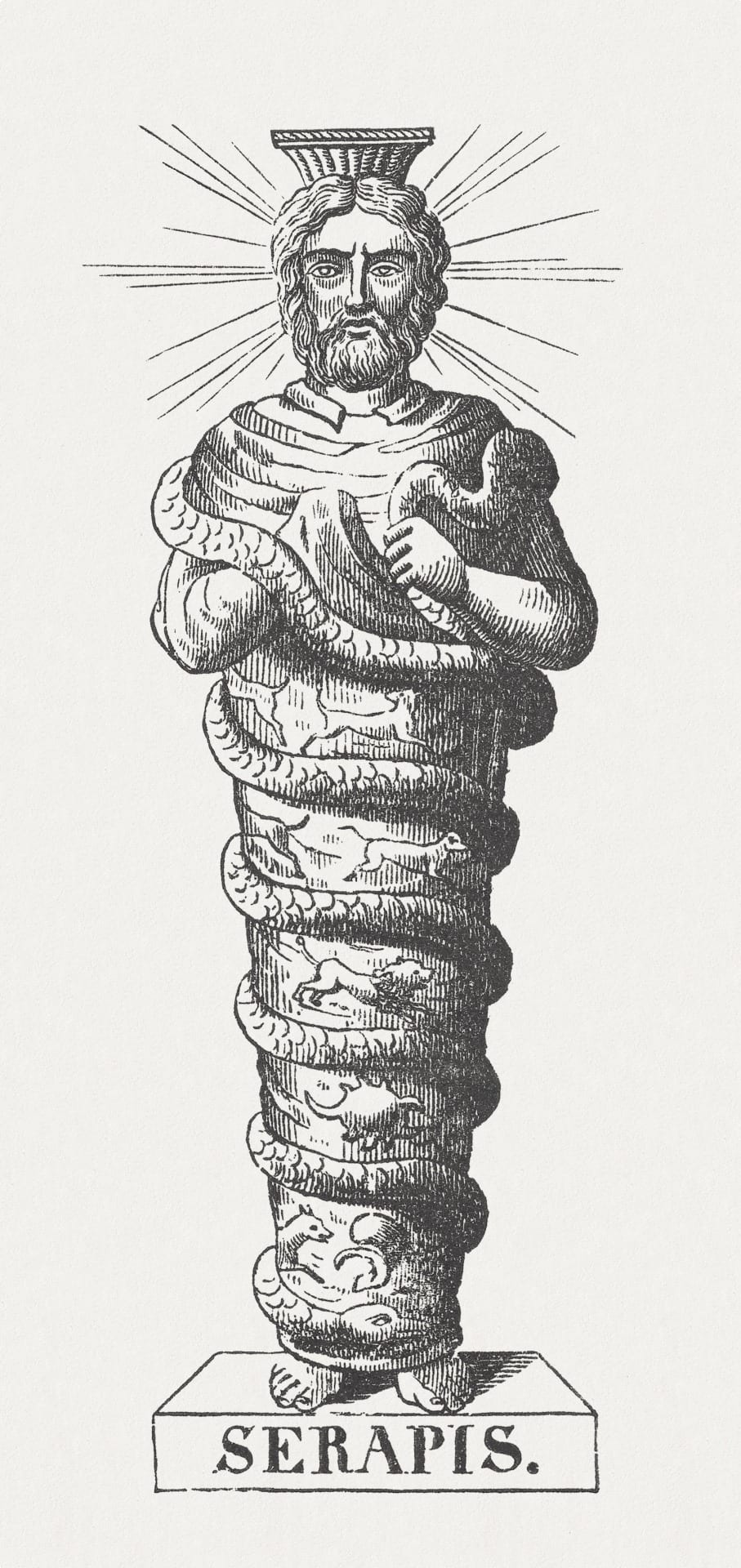
The Greeks were able to accept Serapis as they did not regard their own gods as exclusively Hellenic and believed their manifested themselves in different guises to different peoples. The eclectic nature of Serapis also reflected the sense that there were no sharp boundaries between the twelve Olympian gods.
A Centre of Greek Scholarship
The Ptolemies used their wealth gained from trade to good effect, investing in institutions that reflected a deep dedication to scholarship. Linked to the massive palace complex on the northern side of the city were the buildings of the Mouseion, or ‘museum’. Founded by Ptolemy I Soter and his son Ptolemy II Philadelphus, this was a temple for the Muses, the nine Greek goddesses of artistic, scientific, and poetic inspiration.
The Mouseion was different to modern museums though in the sense that it did not have a collection of sculpture and painting presented as works of art. Instead, it was in effect a university, an institution of learning where scholars could devote themselves to fully to literature, science, and philosophy.
This great institute attracted a great deal of remarkable Greek scholars, scientists, philosophers, mathematicians, artists, and historians. Famous historical figures to have studied there include the mathematician Euclid, the inventor Archimedes, the physician Galen, the philosophers Philo and Plotinus, the geographers Eratosthenes and Claudius Ptolemy, and the engineer Heron of Alexandria (also called Hero).
Abulafia comments on the significant discoveries and contributions of these scholars: “Alexandrian science was of more than local interest. The discoveries and inventions of many of these figures were of lasting importance, and provide further proof of the great vitality of Hellenistic culture, of which Alexandria established itself as the capital.”
The Library of Alexandria
Part of the Mouseion was the Library of Alexandria. This was the greatest library in the ancient world, with estimates that it held up to 500,000 books in its collection, although no one knows how many for certain. The gigantic structure had various spatial features, such as specific reading and dining rooms, lecture halls, gardens, colonnaded walkways, and as its main attraction the great hall holding a vast array or organised bookshelves. A ‘daughter library’ also served as an annex to the main library at the Serapion (a temple to Serapis).

Alexandria Library’s origins lay in a decision by Ptolemy I to collect all the serious writings of all nations. It is believed likely that the whole corpus of Greek literature was amassed in the library, but also many non-Greek texts were collected – including the chronicles of the Egyptian Pharaohs, the Hebrew Bible, and Indian tales. Most of these were likely translated to Greek before they were deposited though.
The quality of the books was of upmost importance, with the Ptolemies determined to lay their hands on the best possible texts of the great authors. To acquire various rare specimens of literary works, royal members of Egypt would go on sponsored trips to well-known book fairs in places like Athens and Rhodes. Many of the items in the library were bought, while rulers and scholars were also invited to contribute their books to the collection.
Other, less cordial, means were also used to obtain items. Every commercial ship entering Alexandria’s harbour were searched for books and papyrus rolls, for example. Those found were then either confiscated or returned after copies were made. The Ptolemies also conned the Athenians into sending their master copies of the plays of Aeschylus, Sophocles and Euripides for copying and then never returned them.
Sadly, no original material from this great library now survives, with the library destroyed multiple times over a period of 700 years. It was first burned in 48 BCE by Julius Caesar intervening in the civil war between Cleopatra and Ptolemy XIII. Then later again it was burned by the newly dominant Christians in the city under Pope Theophilus of Alexandria’s papacy (385-412 CE). A final blow came in 642 CE, following the Arab invasion of Alexandria. The Muslim ruler Caliph Omar ibn Al-Khattab declared the contents of the library as heresy and burned them as tinder in the city’s bathhouses.
Lighthouse of Alexandria
The second important innovation under Ptolemy I and II was the building of their great lighthouse on the island of Pharos at the entrance to the harbour. This was by far the most impressive lighthouse of antiquity, and one of the tallest structures, standing 135 metres (440 feet) above the waves. It was accordingly classed as one of the great ancient wonders of the world, the only with a practical, secular use.
In part, the lighthouse was built out of necessity, with shoals close to the shore invisible at night and hard to track by day. Its purpose was to make approaches to Alexandria safer, which was necessary for the city to achieve its potential as a centre for trade across the Mediterranean.
The building was constructed in three tiers. The lowermost part was a broad square section with four huge facades. On this platform stood the second level – an octagonal tower. And crowning the building on the upper-most, slimmest section was a circular colonnade, with a massive statue of Zeus at the very top.
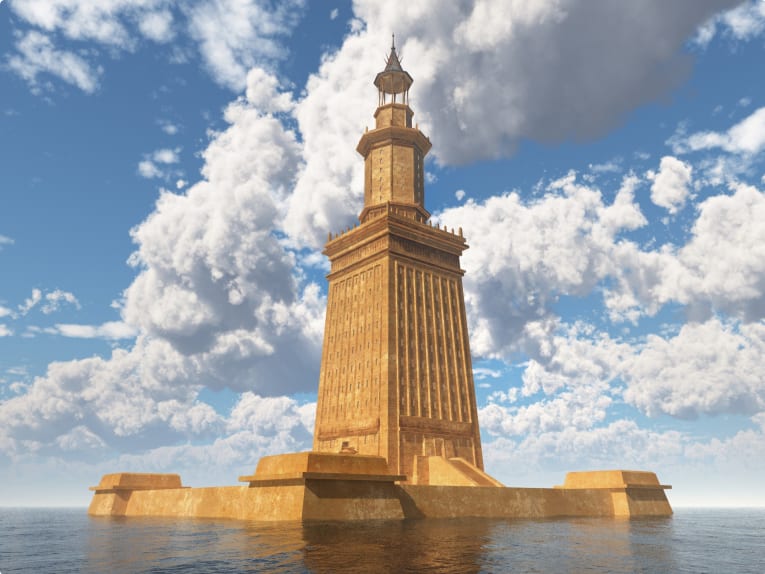
Scholars believe great metal mirrors on the top platform reflected light during the daytime and fire during the night, both which could be seen many miles out to sea.
It is believed the top tier of the lighthouse had collapsed by 796 CE, while the rest was destroyed by devastating earthquakes at the end of the 14th century. Today the remains lay underwater, near where it once stood, by Fort Oait Bey.
Tour of Alexandria Egypt
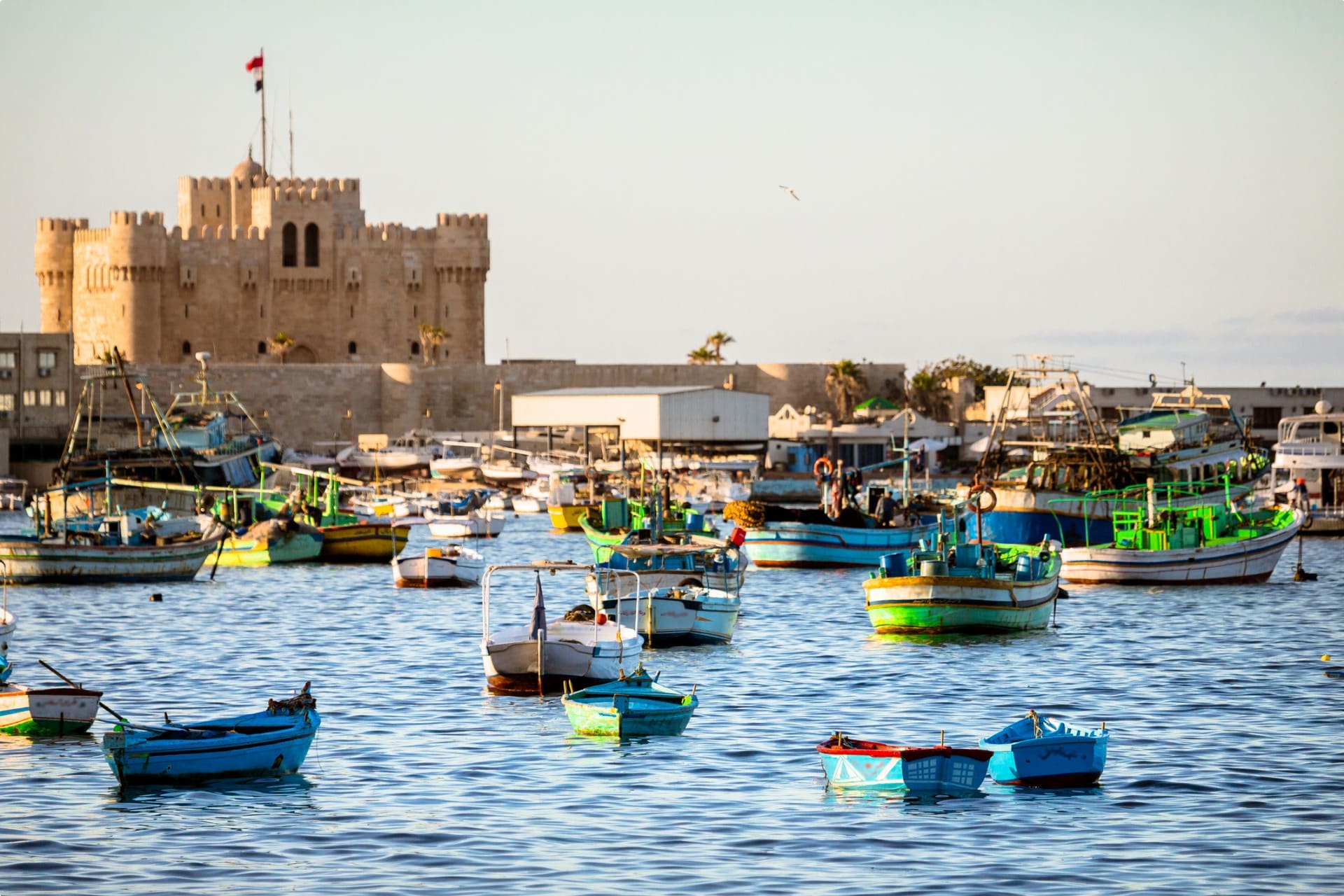
Odyssey Traveller conducts a tour of Alexandria as part of our 17-day Escorted Small Group History & Cultural Tour of Egypt for mature and senior travellers. During our Alexandria city tour, we visit the Catacomb (Kom El Shoafa), which is a remarkable example of the Alexandrian blend of Greco-Roman and Egyptian styles, carved into 100 feet of solid rock and the Roman Amphitheatre. Next, we visit the Alexandria Library, which was reopened in April 2002, with the ambition of reclaiming its former glory and prestige. We then continue to the Montazah gardens of the Montazah Palace. Originally built in 1892, the palace was the summer home of the Egyptian royal family. All this and more can be experienced as part of the Alexandria day trip on our Egypt tour.
Other highlights of our Egypt tour include:
- The Oasis of Wadi El Seboua, Alexandria, and El Alamein.
- A cruise down the Nile River, with shore excursions to Luxor, the Valley of Kings, and Kom Ombo.
- The Red Pyramid, the Great Pyramid, the Valley Temple, and the Great Sphinx.
- The Temple of Philae, the 3000 year old Abu Simbel, and Lake Nasser.
Other tour operators or tour companies may simply survey the archaeological sites and monuments to the Pharaohs and the Giza pyramids. Our Egypt tours, however, also visits contemporary feats such as the Aswan Dam and lets us witness landmarks of the contemporary Egyptian experience, such as Tahrir Square. These sites show that Egypt’s role as the pivot of civilisation is far from ended.
Odyssey Traveller has been serving global travellers since 1983 with educational tours of the history, culture, and architecture of our destinations designed for mature and senior travellers. We specialise in offering small group tours partnering with a local tour guide at each destination to provide a relaxed and comfortable pace and atmosphere that sets us apart from larger tour groups. Tours consist of small groups of between 6 and 12 people and are cost inclusive of all entrances, tipping and majority of meals. For more information, click here, and head to this page to make a booking.
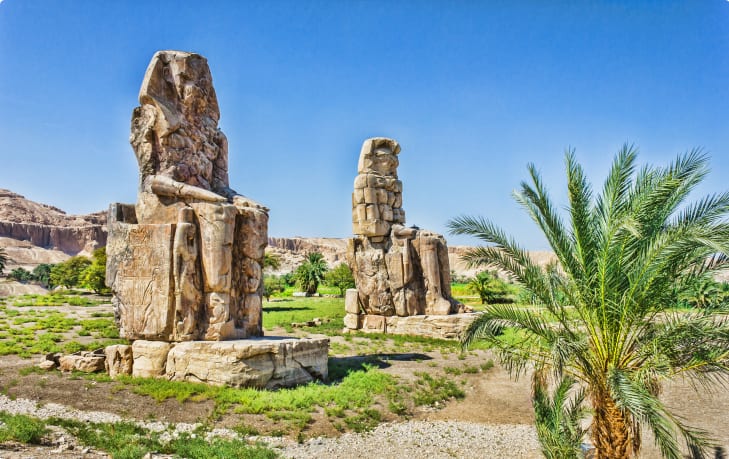
Articles published by Odyssey Traveller about Egypt.
The following articles may also be of interest:
- From Cairo to NAC: Egypt builds a new capital city
- Discover Egypt with 10 great books
- Egyptian Linen Treasures
- Top 20 World Heritage Sites You Must Visit
Links to External Sites About Egypt.
Learn more about Egypt before you travel with these articles and links to external sites.
- Egypt the country. A country profile from Odyssey.
- More small group tours to Africa
- Mesopotamia – HISTORY
- Ancient Near East and Egyptian | Penn History of Art
Related Tours
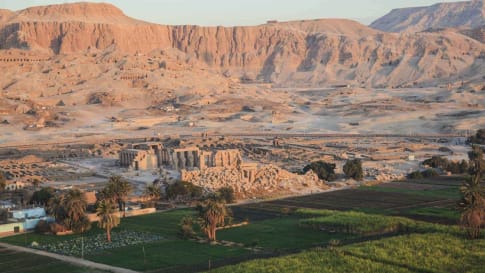
18 days
Nov, JanEgypt tour: escorted small group history & cultural tour of Egypt
Visiting Egypt
Our small group program for senior and mature couples and solo travelers takes us to contemporary feats such as the Aswan Dam and also to current crucibles of the Egyptian experience such as Tahrir Square. Proof, were it needed, that Egypt’s role as the pivot of civilisation is far from ended. There is the opportunity to visit our Morocco, Jordan or Iran tours before embarking on this tour of Egypt.
From A$12,950 AUD
View Tour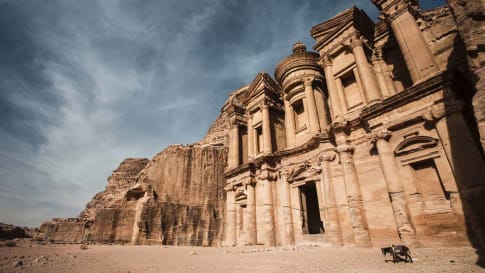
9 days
Jan, OctAncient History of Jordan | Escorted Small Group Tour
Visiting Jordan
Explore Jordan, visiting its capital city, Amman Jordan, the ancient Desert Castles, Petra and the Dead Sea on a small group package tour for mature and senior travellers travelling as a couple or Solo.
From A$6,750 AUD
View Tour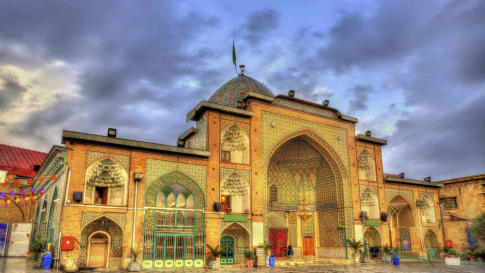
17 days
Sep, Nov, AprIran Culture and History Escorted Small Group Tour for seniors
Visiting Iran
Unlike its neighbours to the west and northwest, Iran had not adopted Christianity and it was the explosive spread of Islam and its ready adoption, without the Arabic language or customs, which helped unite the culture and greatly enrich Persian heritage. This small group tour program includes the great cities of Iran, historic sites, mosques, gardens, bazaars and teahouses for couples and solo travellers.
From A$11,825 AUD
View Tour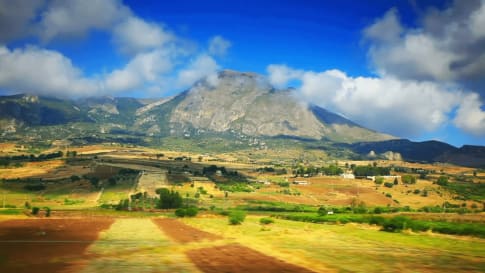
25 days
Apr, Sep, OctMediterranean Islands Small Group Tour | Malta, Sicily, Sardinia and Corsica
Visiting Corsica, Italy
For centuries Malta, Sicily, Sardinia and Corsica held the key to the Mediterranean. Unlike other European tour companies, Odyssey provides a tour leader and local guides to share detailed itineraries about the destinations on these small group journeys. This escorted tour of western Mediterranean explores the geography, history, culture and peoples of these 4 islands. Small group tour for mature couples and solo travellers. A reasonable single supplement is charged.
From A$19,750 AUD
View Tour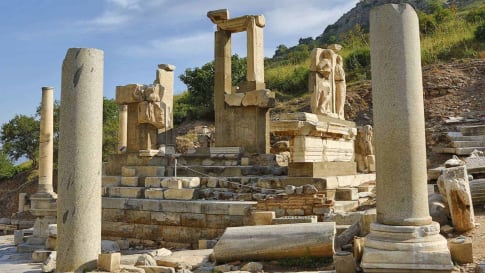
21 days
Apr, AugSmall group tour of Ancient Turkey
Visiting Turkey
As a travel company we seek to keep guests off the beaten path. Trips that are remembered for authentic experiences. Our small group journeys in Turkey are fully escorted by an experienced local guide and an Odyssey guide to give this type of experience whether at one of the many UNESCO World heritage sites explored or local bazaars. It is always about the adventure and memories that we will create.
From A$17,295 AUD
View Tour
20 days
Sep, AprCrete Small Group Tour: The Minoans
Visiting Greece
Crete rich in UNESCO World heritage sites this small group escorted tour provides a travel experience for guests with experienced local guides to remember. For senior couples or single travellers who seek to travel with other like minded people to destinations rich in ancient history then this in one of many small group journeys to be enjoyed.
From A$13,500 AUD
View Tour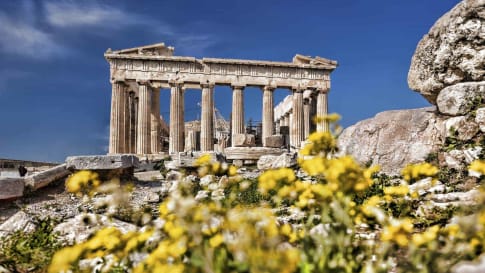
22 days
Apr, Sep, MayGreece small group escorted history tour
Visiting Greece
Our 22 day small group tour explores the land of great philosophers, myths, and legends. We will learn about the culture and heritage of modern Greece whilst exploring and learning Athens, which only found independence in its uprising from the Ottoman Empire in the 19th century.
From A$14,145 AUD
View Tour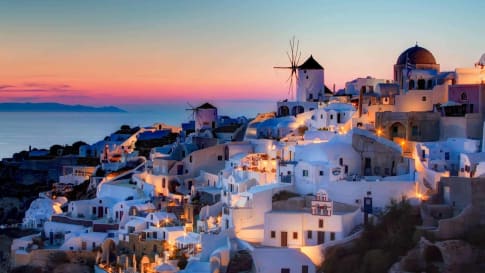
21 days
Apr, OctSantorini, Crete and Cyprus Small Group Tour | Eastern Mediterranean Islands Tour
Visiting Cyprus, Greece
A fascinating small group tour, with an amazing mix of culture and history – the islands of Greece, the cradle of Western civilisation, where traces of a centuries-old history exists. Visit Santorini, a remnant of a volcanic era; Crete, the home of the Minoan civilisation with important archaeological finds at Knossos and Phaistos. Rhodes, inhabited since the Stone Age; and venture further to the island of Cyprus, where east meets west.
From A$17,545 AUD
View Tour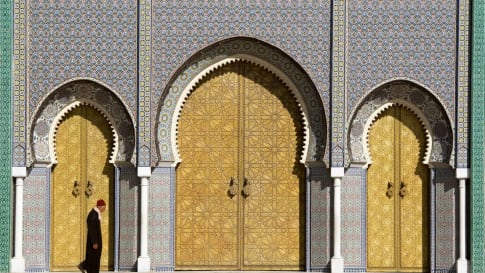
20 days
Apr, Oct, MarMorocco tour for senior travellers
Visiting Morocco
Embark on an unforgettable journey through Morocco: A Gateway to a world of vibrant colors, cultural diversity, and endless wonder. Join our escorted small group tour designed for senior travellers, whether you're a couple or a solo adventurer, and immerse yourself in the captivating allure of Casablanca, Fez, Meknes, Rabat, Marrakech and beyond. Experience the richness of Moroccan traditions and heritage as we explore this enchanting destination.
From A$11,915 AUD
View Tour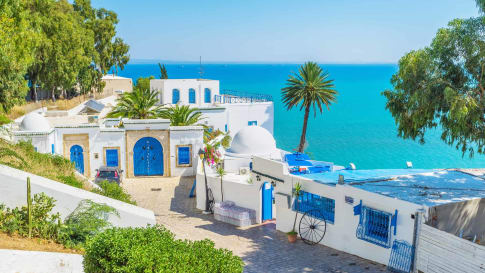
14 days
Apr, Sep, MarTour of Tunisia
Visiting Tunisia
Join Odyssey Traveller on this small group tour of Tunisia in North Africa for couples and solo travellers, where Carthaginian ruins sit side by side with Roman monuments, grand Islamic mosques, Arabic souks and medina, and honeycomb-like Berber cave dwellings and hilltop villages.
From A$10,995 AUD
View TourRelated Articles
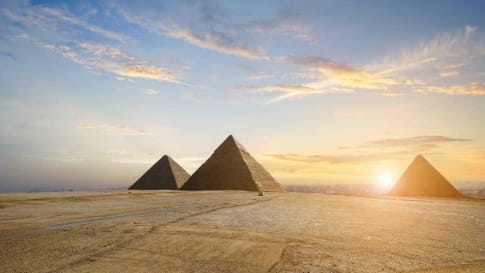
Cairo development site reveals ancient statue
History of Egypt revealed in ancient statue found in Cairo In March 2017 Egyptian and German archaeologists in Cairo discovered a large quartzite bust buried 2 m below ground level […]

Discover Egypt with ten great books
Discover Egypt with ten great books Egypt captures the imagination and heart of us all. It is often our introduction to ancient history, and the mysteries of the pyramids and myths of pharaohs remain alive…
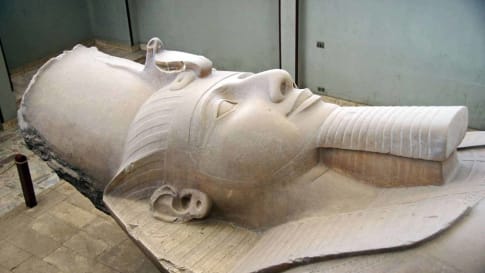
Egyptian linen treasures
Egyptian linen treasures Egypt has long held a place in the imagination of curious travellers. Many of us were introduced to the stories of pyramids, pharaohs and buried treasure as children, and since then, books…
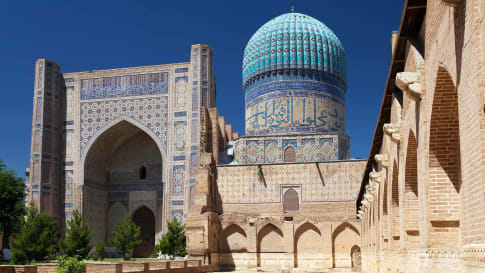
Elements of Mosque Architecture
The word "mosque" often brings to mind not this simple prayer space, but the ornately decorated monuments built by powerful Islamic rulers.
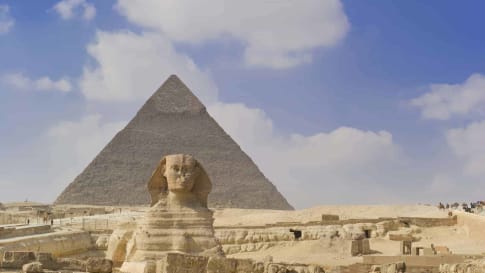
The Pyramids and the Sphinx
Egypt is home to one of the only remaining wonder of the Ancient World: The Great Pyramids of Egypt. The pyramids are monumental tombs for pharaohs from the 4th dynasty and relics of Egypt's Old Kingdom era, constructed around 4,500 years ago.
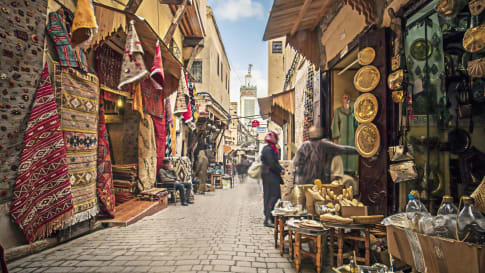
The Fascinating History of the World's Oldest Library
Al-Qarawiyyin Library and University, Fez There is something magical about the medina, or old city, of Fez. Many liken it to stepping back in time as travellers get lost amongst the labyrinthine sandstone walls of…

The Phoenicians and Purple Dye
Article supporting tours to Morocco, Tunisia, Spain, Sicily and Crete. The Phoenicians where one of the empires controlling the Mediterranean sea from the 11th to 13th century. This article is for small group educational tours for senior couple and mature solo travellers joining a program.

